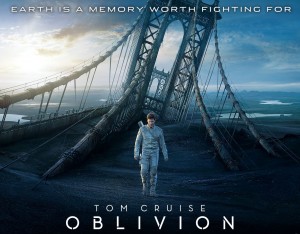By JoJo Brinkhoff
Entertainment Editor
On April 19, director Joseph Kosinski delighted audiences with his latest sci-fi movie Oblivion. Starring Tom Cruise and Morgan Freeman, Oblivion made a total of $37 million over opening weekend in theaters.
Set in the year 2077, after an extra-terrestrial war, Jack (Cruise) and Victoria (Andrea Riseborough) are stationed in the ruins of New York to repair drones and watch over the supply ships, which transport earth resources to another planet where the last of the human race now resides.
Everything runs smoothly until Jack discovers other humans still living on earth. After meeting their leader, Beech (Freeman), Jack begins to question his real mission and what his commander Sally (Melissa Leo) is hiding from them.
Despite being a typical sci-fi movie, the storyline was well executed, keeping the audience guessing and allowing them to understand what was happening without making it too confusing.
The computer-generated imagery (CGI) was done wonderfully. The colors and details were not overwhelming, which made it easy for the audience to focus on the action instead of being distracted with the background. The landscape was breathtaking; a simple forest growing over buildings which were still recognizable for the audience.
Another bonus to the film was the number of characters. With only six principal characters, the viewers are able to know exactly who they are without mixing them up with each other.
However, because extra time was spent on Jack, Victoria and a surviving human named Julia (Olga Kurylenko), it was hard to connect with Beech and his second-in-command Sykes (Nikolaj Coster-Waldau). The time used for Jack and Victoria’s make-out scene in the swimming pool, for instance, could have been spent focusing on Beech and Sykes instead. Even the scene where Jack takes Julia to his “favorite place” could have been spent developing Sykes’ importance to the movie.
Despite these flaws though, Cruise and Freeman proved excellent choices for their characters. Cruise, for example, knew exactly how to communicate to the audience his longing to live on earth without being overly emotional or struggling to express his passion.
As for Freeman, because he wore dark-tinted sunglasses throughout the movie, it was hard to see his expressions. However, Freeman captured the audience as always through vocal expression. His voice alone allowed the audience to hear his dreams and desires without having to see it in his face.
Riseborough’s performance, on the other hand, made it hard to understand her character. Throughout her scenes, she seemed like she was supposed to be a robot with human characteristics through her posture and her emotion. For instance, she hardly showed emotion or facial expression in most of her scenes, but suddenly became emotional and extremely expressive in the scene when she is angry at Jack.
Kurylenko’s faults, however, were on the opposite end of the spectrum. When the audience meets her, she seems like she is trying to capture their attention by constantly having tearful eyes and through her relationship with Jack. Nonetheless, her performance felt more natural toward the end.
Overall, Oblivion is certainly not one of those “you have to see this on big screen” or “you have to buy it the moment it comes out” type of movie. However, it is definitely a movie worth seeing.


Leave a Reply